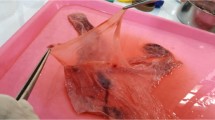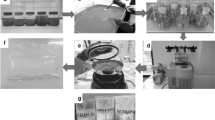Abstract
A burn is a devastating phenomenon, especially in the developing countries. A bulk amount of medical resources is required to fulfill the demand of burned patients. So, it is very important to find another alternative for the treatment of burned patients. Recently, human amniotic membrane (AM) and Moringa oleifera (MO) are being used separately to treat wounds and burn. In this study, we tried to use a mix of AM and MO formulated to a gel with sodium carboxymethylcellulose (CMC-Na), propylparaben, glycerin, distilled water, and triethanolamine and applied on the burned skin of Wistar rats. Second-degree burns were created using pieces of aluminum (2.5-cm diameter). Skin irritation study, physiological properties, the percentage of wound contraction, and epithelialization period were measured for all groups. AM+MO-treated group had maximum average body weight, food intake, and water intake. At day 24, AM+MO group showed a greater response (p < 0.00003667) than other groups. For complete epithelialization, AM+MO required only 19.6 days while AM, MO, and control group needed 23.2, 28.2, and 31.4 days, respectively. These results suggested that the combined composition of AM+MO may be used as a good therapeutic agent to treat burn and wound.
Lay Summary
Since burn injury is a major clinical concern throughout the world, we performed a study with 20 rats to treat burns with minimum cost and quick healing rate. Three types of burn healing gels (AM gel, MO gel, and AM+MO combined gel) were prepared. The second-degree burn was created on the dorsal part of each rat’s skin and gels were used for that portion twice a day while Povisep solution was used in the control group. The rats of combined group (AM+MO) showed the maximum healing rate (96 ± 1.96%), maximum epithelialization (19.6 days), progressively body weight gain, and increased food and water intake.








Similar content being viewed by others
Abbreviations
- AM :
-
amniotic membrane
- MO :
-
Moringa oleifera
- ITBBR :
-
Institute of Tissue Banking and Biomaterial Research
- ECM :
-
extracellular matrix
- EMT :
-
epithelial-mesenchymal transition.
References
Marks R. The stratum corneum barrier: the final frontier. J Nutr. 2004;134(8 Suppl):2017S–21S.
Lee SH, Jeong SK, Ahn SK. An update of the defensive barrier functions of skin. Yonsei Med J. 2006;47(3):293–306.
Rubin E, Fabrex JL. Repair, regeneration and fibrosis. In: Pathology. 2nd ed. Philadelphia; 1996. pp. 7–15.
Velnar T, Bailey T, Smrkol JV. The wound healing process: an overview of the cellular and molecular mechanisms. J Int Med Res. 2009;37:1528–42.
Crovetti G, Martinelli G, Issi M, Barone M, Guizzardi M, Campanati B, et al. Platelet gel for healing cutaneous chronic wounds. Transfus Apher Sci. 2004;30:145–51.
Eming SA, Krieg T, Davidson JM. Inflammation in wound repair: molecular and cellular mechanisms. J Invest Dermatol. 2007;127:514–25.
Blanpain C, Fuchs E. Stem cell plasticity. Plasticity of epithelial stem cells in tissue regeneration. Science. 2014;344:1242281.
Werner S, Grose R. Regulation of wound healing by growth factors and cytokines. Physiol Rev. 2003;83:835–70.
Arnold KM, Opdenaker LM, Flynn D, Sims-Mourtada J, et al. Wound healing and cancer stem cells: inflammation as a driver of treatment resistance in breast cancer. Cancer Growth Metastasis. 2015;8:1–13.
Yenerman M. Genel Patoloji, Istanbul Üniversitesi, Istanbul, Turkey. 1st ed; 1986, pp. 271–294.
Madri JA. Inflammation and healing. In: Kissane JM, editor. Anderson’s Pathology, vol. 1. St. Louis: The C.V. Mosby Company; 1990. p. 67–110.
Atiyeh BS, Hayek SN, Gunn SW. New technologies for burn wound closure and healing—review of the literature. Burns. 2005;31:944–56.
Johnson RM, Richard R. Partial-thickness burns: identification and management. Adv Skin Wound Care. 2003;16:178–87.
Xue L, Xu YB, Xie JL, Tang JM, Shu B, Chen L, et al. Effects of human bone marrow mesenchymal stem cells on burn injury healing in a mouse model. Int J Clin Exp Pathol. 2013;6:1327–36.
Subrahmanyam M. Amniotic membrane as a cover for microskin grafts. Br J Plast Surg. 1995;48:477–8.
Gruss JS, Jirsch DW. Human amniotic membrane: a versatile wound dressing. Can Med Assoc J. 1978;118(10):1237–46.
Gothai S, Muniandy K, Zarin MA, Sean TW, Kumar SS, Munusamy MA, et al. Chemical composition of moringa oleifera ethyl acetate fraction and its biological activity in diabetic human dermal fibroblasts. Pharmacogn Mag. 2017;13(3):S462–9.
Gotha S, Arulselvan P, Tan WS, Fakurazi. Wound healing properties of ethyl acetate fraction of Moringa oleifera in normal human dermal fibroblasts. J Intercult Ethnopharmacol. 2016;5(1):1–6.
Ramey PI, Barret JP, Herndon DN. Thermal injury. Crit Care Clin. 1999;15:333–52.
Bose B. Burn wound dressing with human amniotic membrane. Ann R Coll Surg Engl. 1979;61:444–7.
Trelford J, Trelford-Sauder M. The amnion in surgery, past and present. Am J Obstet Gynecol. 1979;134:833–45.
Rathi BS, Bodhankar SL, Baheti AM. Evaluation of aqueous leaves extract of Moringa oleifera Linn for wound healing in albino rats. Indian J Exp Biol. 2006;44:898–901.
Siddhuraju P, Becker K. Antioxidant properties of various solvent extracts of total phenolic constituents from three different agroclimatic origins of drumstick tree (Moringa oleifera Lam). J Agric Food Chem. 2003;51:2144–55.
Dillard CJ, German JB. Phytochemicals: Nutraceuticals and human health: a review. J Sci Food Agric. 2000;80:1744–56.
Thurber MD, Fahey JW. Adoption of Moringa oleifera to combat under-nutrition viewed through the lens of the “Diffusion of Innovations” theory. J Nutr Ecol Food Res. 2009;48:212–25.
Olugbemi TS, Mutayoba SK, Lekule FP. Effect of Moringa (Moringa oleifera) inclusion in Cassa based diets fed to broiler chickens. Int J Poult Sci. 2010;9:363–7.
Busani M, Masika PJ, Hugo A, Muchenje V. Nutritional characterization of Moringa (Moringa oleifera Lam.) leaves. Afr J Biotechnol. 2011;10:12925–33.
Nascimento EG, Sampaio TB, Medeiros AC, Azevedo EP. Evaluation of chitosan gel with 1% silver sulfadiazine as an alternative for burn wound treatment in rats. Acta Cir Bras. 2009;24(6):460–5.
Zohdi RM, Zakaria ZAB, Yusof N, Mustapha NM, Abdullah MNH. Gelam (Melaleuca spp.) honey-based hydrogel as burn wound dressing. Evid Based Complement Alternat Med. 2012;2012:843025.
Khan AW, Kotta S, Ansari SH, Sharma RK, Kumar A, Ali J. Formulation development, optimization and evaluation of aloe vera gel for wound healing. Pharmacogn Mag. 2013;9(Suppl 1):S6–S10.
Author information
Authors and Affiliations
Corresponding author
Ethics declarations
Conflict of Interest
The authors declare that they have no conflict of interest.
Human and Animal Rights and Informed Consent
The study was conducted in accordance with the internationally established principles of the US guidelines (NIH publication # 8523, revised in 1985). The experiment protocol was approved by the Biosafety, Biosecurity & Ethical committee of Jahangirnagar University.
Rights and permissions
About this article
Cite this article
Islam, M.M., Hossain, M.L., Diba, F. et al. The Combined Effect of Amniotic Membrane and Moringa oleifera Leaves Derived Gel for Wound and Burn Healing in Rat Model. Regen. Eng. Transl. Med. 4, 177–186 (2018). https://doi.org/10.1007/s40883-018-0060-4
Received:
Accepted:
Published:
Issue Date:
DOI: https://doi.org/10.1007/s40883-018-0060-4




